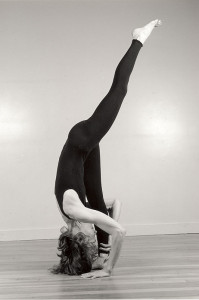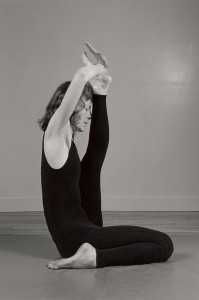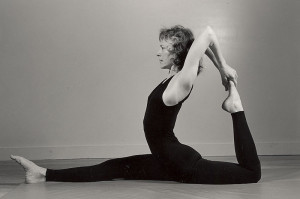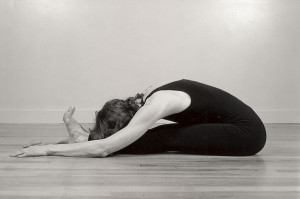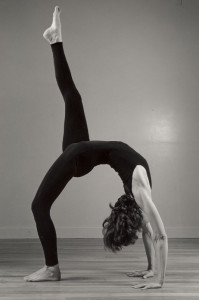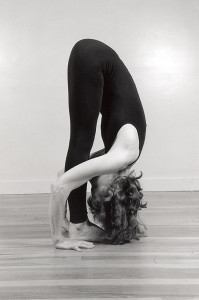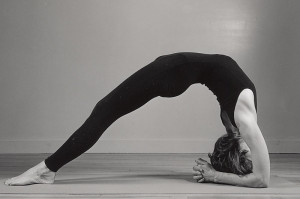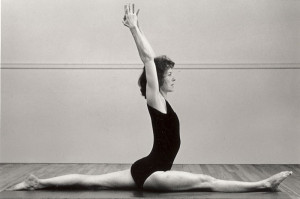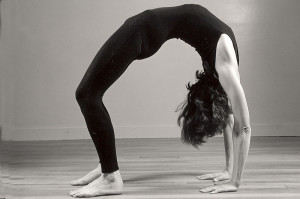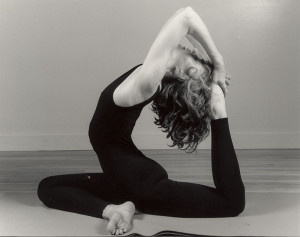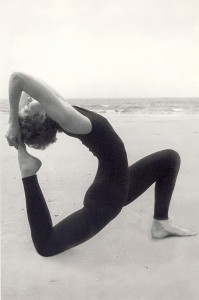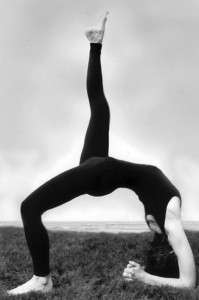YOGA
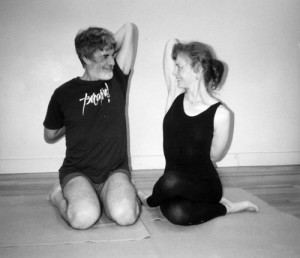
Yoga continues to wield such a deep and far-reaching influence on my life (as it did on Francis’ life) I am prompted in this website, to put a spotlight on it. As A Love Story demonstrates, it was yoga that led Francis and me to both the Dances of Universal Peace and to Permaculture.
First of all, it holds all the more significance for me since it came to us because of Francis’ remark. He repeated, in a declarative voice, this comment he had heard during a demonstration at his workplace: “Yoga massages the internal organs.” That was in 1978. It so intrigued me I was spurred to buy a book on yoga and to begin a practice I found so compelling I travelled out of state to get further training. Six years later, in 1984, I left my academic teaching profession of twenty-three years in order to devote myself full time to much yoga practice and a modest yoga teaching schedule at the University of Southern Maine. Then in 1989, five years later, Francis and I founded Portland Yoga Studio.
I was forty-three years old when I started practicing yoga. Francis was in his mid-fifties, and my mother, in her sixties. The knee replacement surgery her doctor had proposed was rendered unnecessary because simple yoga stretches freed her from knee pain.
It’s been since then, in 1978, that Francis and I entered into a wide new world. Yoga changed the course of our lives. And the lives of others, too – for years to come. It helped Francis face his own death in 2010. I learned this year it gave courage to one of my students when she was caring for her dying husband, fifteen years ago.
On our original website, I had written this explanation, under “About Us”: “It only gradually dawned on Francis and me. But it is clear to us now that what had attracted me to become a nun, and him to become a priest sixteen years before we met, is what (by then married) attracted us to yoga: it was the call toward union. That call is at the heart of both the monastic tradition and of yoga. Its very name, ‘yuj’ in Sanskrit, means ‘union’.”
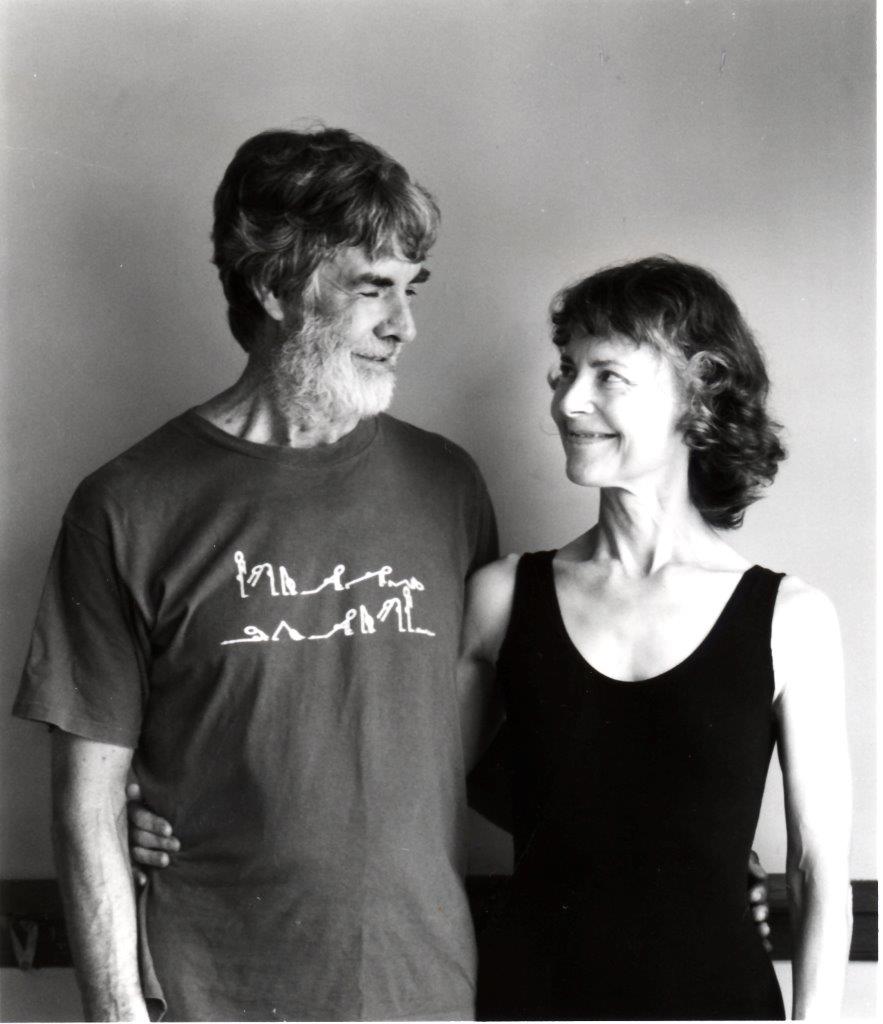
It is more than interesting for me to recall, twenty-four years now, since I expressed these thoughts – that what guided my life then still guides my life now as a widow who is living a largely monastic life. This “yuj,” the “yoking together” or “union” which is its very definition – that still powerfully draws me, because the essence of union is love.
I spent nine weeks studying yoga with B.K.S. Iyengar, in Pune, India, the year we opened the studio. Three sayings of this world-renowned master born in 1918, made a lasting impression on me. The first is: “When you are fully in the body, you meet the soul.” This saying of B.K.S. Iyengar expresses so well what I experienced practicing yoga postures that Francis and I commissioned our friend and artist, Sally Waite, to feature it on a 10 x 4 ft banner which we hung on the studio wall. We wanted to inspire our students with its truth. I still marvel at the wonder of that mystery. When I was trying to think of slogans to use to promote the studio, I came up with – “Iyengar-style yoga penetrates to the marrow of the bones and the depths of the heart.”
Those who have been in Iyengar-style yoga classes know how detailed and specific the instructions are – how to press the bones of the feet into the floor, arches lifting, evenly aligned, arms uplifted evenly, and so on. “We bring God to every cell,” Mr. Iyengar said. It reminds me of Irenaeus’ saying – “The glory of God is {the human} fully alive.” That’s what yoga does for me. I could go into much detail demonstrating the accuracy of Guruji’s comment (Guruji, as he is affectionately called). It’s anatomically a fact that the varied postures taken together do oxygenate and hydrate and so, enliven, every cell – “bringing God” to it.
In his book, The Tree of Yoga, Mr. Iyengar writes that yoga is “aparuseya . . . not given by man.” Amen indeed! I believe my identifying strongly with that quote has something to do with my mysterious hip problem which has led me to discover the body’s wisdom. I am in awe at how the body itself possesses an irresistible driving force toward health. I’ve found the intricacies of its language downright mysterious. I remember telling my students that what my body tells me to do to get free of the “knot,” is so clear, it as much as talks to me. That’s why I wrote six poems about my hip over a period of several years. Here are two of them:
LIKE JACOB
“And there was one who wrestled with {Jacob} until daybreak who…struck him in the socket of his hip.” Genesis 32:25-26
Shackled at the bone, the very bone of hip,
Imprisoned front and back and sides
Bound all round by muscle-binding twine,
Fettered night and day, this thralldom of
Obstruction and resistance,
Hindering and hampering me,
Checking and arresting me,
Fixating me on
Hip, hip, hip,
Bars and cramps, entraps and hamstrings me!
Driven to cut and snap the bonds with
Asana and Pranayama
Impelled to elongate and lengthen
Stretch my reach beyond far stars,
Our stuff,
To get unstuck
Beyond the pull of sinews’ now
Scintillating sweet pain,
I discover the knot itself: [
The blazing fireball that
Forges bonds of union in my trembling bones and
Batters my throbbing heart,
Ravished by my insistent, Irresistible Love.
(May 1993)
*Asana and Pranayama – Sanskrit for yoga posture, and for yogic breathing
THE FOUNTAIN OF ASANA
Ah! Those femur head balls!
Can you feel them
rolling
in socketed
domes
as you walk?
What sukha satisfaction,
the very stuff of asana —
this pleasure in legs
ligamented bone to bone to bone
moved by muscles
juicy now at last!
Imagine! Finally, now, at 68
to feel the pumping pulse of
squeeze and soak and slack,
contract, relax,
in aging legs that
found the fountain through asana!
(March 2004)
* sukha: Sanskrit for pleasure, comfort, ease.
My Hip Story Related to the Yoga Photos Below
The following photos of me in some pretty advanced yoga postures call for an explanation. I often told my yoga students and friends that I could write a book about my hip. Well, I doubt I’ll do that, but in Sing to Me and I Will Hear You – A Love Story, I devoted several paragraphs to telling my hip story.
When I was five-years old, a moving car came within inches of hitting me while I was crossing the street where I lived at the square of our small town. It left my right hip muscles in trauma. Though no obvious scars marred my body, those muscles went into a deep contraction that wouldn’t let go. As a result it became, and remained, fibrous at the core. Chronically contracted, numbed tissue in a state of amnesia, creates pain. As an adult, its nagging was low grade, since it was largely dormant. No one could find anything wrong with it. It was something people had to live with, I was told.
But after ten years of yoga practice, when I was fifty-three, the postures began unearthing the pain. Unbelievably the hip was reaching for release after all those years. While in Pune, India studying yoga for nine weeks even B.K.S. Iyengar could not solve my hip problem. It would take me another ten years (when I turned sixty-three) to understand what had happened. Although unable to cure me, body workers helped. What I assimilated from my anatomy teachers, and in particular from Tom Myers, was invaluable, even if it was my own body that guided me toward a satisfactory solution.
It was not eagerness to perform advanced poses for their own sake that led me into a deep yoga practice, it was the relief the postures provided by eventually transforming tough fiber into flesh. In the early stages, to describe the changes in how a specific muscle complex felt in that process which took years, I used the similes: a metal cable, a fiber rope, a rubber hose, and then, thera-band resistive tubing.
I will never forget, nor cease to be grateful for, Francis’ patience putting up with my talking about my hip, especially in the early years. I tried to hold back in his presence when talking with friends by saying, “Poor Francis, he hears about my hip all the time.” He appreciated the fact that my experience helped me understand my students’ physical problems. He saw for himself also how much it encouraged them to hear and see for themselves that it’s possible to change chronically contracted muscles. (“Persistence pays off is my motto,” I told them.) But Francis had to be charitable to hear me recount the latest development he had already heard about at home.
He told me at some mid-point in the process, “You’ll always have this; it’ll never end.” No wonder it seemed unending – it took me about thirteen years to reach and release the core of the contracture or “knot.” I was as gratified as he when, in 2004, it reached that point. Now, although the muscle tissue repeatedly shrinks back into its old knotted state daily – a daily yoga practice just as dependably unbinds it. I count it a blessing, too, that this regularity of a deep practice keeps me fit.
It must be noted, too, that Francis was very proud of the good results my tenacity brought. Before other teachers joined me to teach classes at the studio, for our brochures, we used photos of me in some of the poses that had helped release my hip. He kept extra copies of them in his leather, male purse to hand out when someone inquired about yoga. The one he liked to show off was the photo of me in Eka Pada Raja Kapotasana II (One Foot King of the Pigeon Pose), a backbend in which the practitioner’s two hands bring one foot onto the head. I want to celebrate all this: Francis’ patience, my diligence, and the wizardry itself of yoga postures.”
In reflecting further on this hip issue of mine, which actually continues to be mysterious even if greatly improved (the release comes more readily), I remembered as I write this now that a gifted body-worker friend of Tom Myers, to whom Tom had sent me some years ago, concluded after examining me that “the common iliac artery” at my right hip was “bound up” by the tissue. He also had concurred with the likelihood of the childhood trauma cause. In any case, I have ceased to ask questions, since luckily, the certain few specific poses that unfailingly free me daily are so simple and easy, I should be able to practice, or rather remain in, them even into real old age.
A forty-five year old friend who is a personal trainer and teacher of exercise and movement for women told me I must make it clear that I was sixty years old when the first ten photos were taken inside our yoga studio, in 1995. My mother died on April 3, 2000. I was sad she didn’t live a few more months to see me turn sixty-five years old when the outdoor photos were taken, near the ocean, for she was proud of me (and of Francis, too). At least, she lived to see me teach, and Francis model, a three-minute live segment on CBS television, one yoga pose a month. (We did that for three years.)
Yoga postures are good “vehicles for self-exploration and rehabilitation” as I would tell my students. But they mean even more to me than that. The person who designed our quarterly yoga brochures is the one who suggested I create postcards and notecards of these twelve photographs. We had originally used them to notify our students of seasonal changes in yoga class and workshop schedules. We called the cards the “West Meets East Series: Biblical mantras with Yoga Poses” and I included in the packet, this explanation: “For Elaine, the joy of yoga is that it enables her to give flesh to the cries of the heart expressed in the psalms and other sacred texts of scriptures. Both yoga, which means union (‘yuj’ in Sanskrit – to yoke together) and the images of scriptures, reach beyond words to hint at that ineffable relationship of union.” All this is still true, still real.
While Francis and I owned Portland Yoga Studio, we sold the yoga notecards and postcards to our students, as well as through our website, www.portlandyoga.com, now directed by its new owners. Since I have many of them still on hand, I’ve decided to sell them again, and at a good discount, because the telephone number on the back of the cards has been changed.
The same twelve photos are available both as 6×4 ¼ notecards and as 5 ½ x 3 ¾ postcards. The front of the notecards features one the twelve yoga photos. The scripture mantra is printed on the inside left, and the right inside is blank. The rear, fourth panel, gives the Sanskrit name of the pose with English translation.
TO ORDER:
Use the Contact Form to give me the details of your order, as well as your name, and your email and home addresses.
For payment, use either Paypal (here)—
Postcards: $5. includes S&H
Or (after I email you my home address) — enclose a personal check for the total amount of your choices (indicated on the Memo line):
One set of 12 notecards – $10. ($8. + $2. for S&H)
One set of 12 postcards – $5. which includes S&H)
Our Jail Ministry – Teaching Yoga
In Sing to Me and I Will Hear You – A Love Story, I wrote about Francis’ and my using yoga to engage in peacemaking and ministry. I taught yoga to people with AIDS for five years, to the elderly for two years (with my mother as one of my students) and to inmates at the Cumberland County Jail and the Windham Correctional Center for eleven years.
After one of Francis’ and my yoga classes at the women’s pod in the Cumberland County Jail, I wrote this poem:
We Went Weekly
to the county jail for yoga —
I, reluctantly —
work interrupted.
But then I saw her
missing tooth,
sad eyes and
red streaked
wrists.
Another’s shoulder
sore from injury.
“An accident,” she said,
“two months ago.”
I wanted now
to bring them balm
for wounds.
With my voice, I soothed them
through posture, breath, repose,
and saw them merge
into themselves
for nourishment.
Reward enough for me
to rouse myself each week.
(June 5, 2003)
Written Interview, “Yoga Means Union” by Renee LaLone
Credits for Twelve Photos of Elaine in the Following Yoga Poses:
Ten taken in the studio by Mary Melilli:
Urdhva Prasarita Ekapadasana (Upward Extended One Foot Pose)
Krounchasana (Heron Pose)
Eka Pada Raja Kapotasana IV (One Leg King of Pigeons Pose)
Paschimottanasana (Back Extension Pose)
Eka Pada Urdhva Dhanurasana (One Leg Upward Bow Pose)
Uttanasana (Intense Stretch Pose)
Dwi Pada Viparita Dandasana (Two Legs Inverted Staff Pose)
Hanumanasana (Monkey Pose)
Urdhva Dhanurasana (Upward Bow Pose)
Eka Pada Raja Kapotasana I (One Leg King of Pigeons Pose I)
Two taken near the ocean by Bill Gillis:
Eka Pada Raja Kapotasana II (One Leg King of Pigeon Pose II)
Eka Pada Viparita Dandasana (One Legged Inverted Staff Pose
Mary Melilli also took the two photos above of Francis and Elaine looking at each other.

